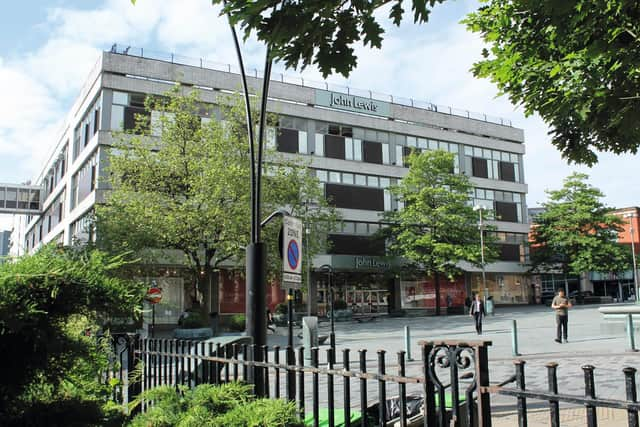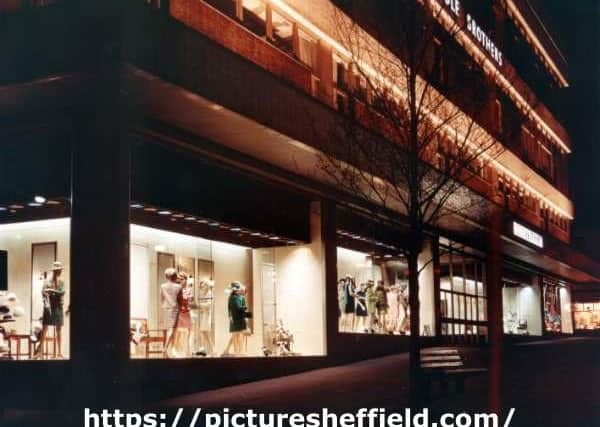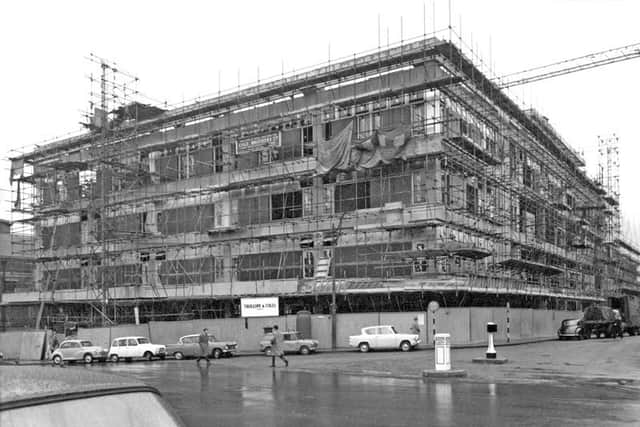Greenwash in Barkers Pool: Carbon and the case for John Lewis
and live on Freeview channel 276
Heritage campaigners once fussed over a Modernist structure being built opposite the historic City Hall, but now realise that it is a fine building, one of the best of our post-war specimens, and with a little imagination and cleaning could be an asset to the city again. Department stores might be in decline, but their buildings once denoted great pride. They deserve a new lease of life.
Sheffield City Council’s recent consultation acknowledges that there is nothing to stop this happening. Even so, voices have been raised favouring its demolition, and they have been listened to. An application to Historic England has been made for a Certificate of Immunity from Listing. Two of the three proposals involve total demolition, with the climate emergency dragooned in support. A “huge boost to the city’s long-term low carbon ambitions” is claimed if it is replaced with a park. The spectre of lurking asbestos rears its head.
Advertisement
Hide AdAdvertisement
Hide AdLet’s take a closer look at that asbestos. How many times has a project being delayed, or exceeded its budget, or even been abandoned, because asbestos was found? It is seen as one of the main challenges to re-use. And yet it is not mentioned at all for either of the demolition options. It is hard to understand why not: it is still very much there, so much so that the Co-operative Executive recently approved £3m for its removal, which a supporting document said “will be required for whichever option is decided for the future of the building”. Of course it will: what could be worse than breaking up a building when it is still full of a mineral that becomes carcinogenic when its dust is inhaled?


Then there are those trees in the proposed park. It is claimed that these will absorb 230 tonnes of carbon dioxide (CO₂) over 25 years, or 9.2 tonnes per year. This “huge” contribution is actually less than the Government’s estimate of the carbon footprint of one average person in the UK. It also seems exaggerated. The Royal Society and Royal Academy of Engineering estimate the CO₂ absorbed by one tree in a year is 10kg. This is more generous than most estimates: the Council’s Trees and Woodlands Strategy and the i-Tree report that supports it make it rather less. To save 230 tonnes over 25 years would require over 900 trees. Not so much a park or a garden, more a dense forest.
The consultation depicts a light, open space with about thirty trees. It won’t even come close.
But carbon emissions are where the trouble lies for the boldest claim in the consultation: that demolition will produce between 1100 and 3450 tonnes less in carbon emissions than re-use. This would be true if the city centre had a supply of vacant zero-carbon buildings – which it doesn’t - or did not need any new buildings at all.
Advertisement
Hide AdAdvertisement
Hide AdUnfortunately, it does. The John Lewis building was the workplace for nearly 300 people, making a substantial contribution to the local economy. We expect to replace those jobs, and add more. The Council’s last City Centre Plan in 2018 predicted over 2,000 additional jobs in the city centre each year. As the City Centre Strategic Vision says, nobody predicts a future that does not include for many jobs still to be carried out in City Centre. If available buildings are not re-used to put them in, new ones will have to be built, and more carbon emitted.


The City Centre Strategic Vision also calls for an extra 20,000 homes, to which the John Lewis building could make a modest contribution. If not there, they certainly have to be somewhere. The same applies whether we want arcades, workshops, a palace of culture or a temple to football. Whatever the John Lewis building could be used for, we will still want to do in other new buildings, if John Lewis is no longer available.
The consultation does not mention this, but the John Lewis Building Carbon Assessment considered by the Executive does, in very opaque language: “Whether this is relevant can only be determined by a needs-appraisal for this remaining area of floorplate in relation to the site, and consideration of the impact of this within the wider socio-environmental-economic context of the city”. It also shows the real carbon cost of the demolition options in dotted lines on a graph, but then disregards it in the final totals. It is the equivalent of not counting the climate cost of the goods we buy, because production has moved to China.
It is relevant. We do need the space. Over the Assessment’s 25-year review period, constructing and using equivalent new buildings would emit 7800 tonnes of CO₂, compared with just 3700 tonnes if the existing building is re-used. Even that requires construction so carbon-efficient that it significantly exceeds the targets set for 2030 by industry-leading bodies RIBA and LETI. Choosing to demolish means an additional 4100 tonnes of carbon emissions displaced to other sites. The claim that demolition is more climate-friendly than re-use is the most misleading of all.
Advertisement
Hide AdAdvertisement
Hide AdThe climate emergency is real. Arguments about carbon emissions can be long and technical, and it is important to remain clear-eyed and hard-headed. There is too much at stake to begin manipulating or airbrushing data to support a preferred solution. It may be that demolition can be justified in other ways, but it must be accepted that it comes at an environmental cost. Heritage campaigners today mostly find that conservation is on the side of the environment, in addition to its social and economic benefits. Research points firmly at re-using old buildings to benefit the climate. That is why a slew of respected professional and scientific organisations, including RIBA, RICS, LETI, the Royal Society, the Royal Academy of Engineering and their counterparts across Europe have reported on the hidden carbon cost of demolition and new build, often advocating strongly for re-use as the first choice.


The Council finds itself out of step in even contemplating the demolition of a building as a serious option. The gaps in its arguments seem to show that even now the real issues are not understood. Demolition in favour of a park might have seemed like a radical and appealing green solution: what could be more environmentally friendly than a park?
But even if it were possible to cram an entire forest onto the site, it would take 445 years before it absorbed the carbon emissions displaced to other sites.
If we sacrifice buildings that could be re-used, then as we build to stem the housing crisis, accommodate a growing economy and meet the needs of Sheffielders, we will create still more climate-harming carbon emissions. They cannot be greenwashed away.